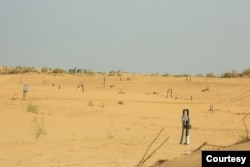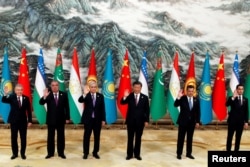U.S. officials hoping to break China's near monopoly on the production of rare earth elements needed for many cutting-edge technologies should engage the governments of Central Asia to develop high concentrations of REEs found in the region, says a new report.
The study by the U.S.-based International Tax and Investment Center warns that a failure to act could leave China with a "decisive advantage" in the sector, which is crucial to green energy, many new weapons systems and other advanced technologies.
"As the uses for these minerals has expanded, so too has global competition for them in a time of sharply increasing geostrategic and geo-economic tension," the report says.
"Advanced economies with secure, reliable access to REEs enjoy economic advantages in manufacturing, and corresponding economic disadvantages accrue for those without this access."
China, which accounts for most of the world's rare earth mining within its own borders, has not yet had to seek additional supplies from Central Asia, which enjoys plentiful reserves of minerals ranging from iron and nonferrous metals to uranium.
But, the report says, "the massive size of the Chinese economy and the Chinese Communist Party's conscious efforts to dominate the REE sector globally mean such increases are a matter of time."
Oil-rich Kazakhstan, the region's economic giant, holds the world's largest chromium reserves and the second-largest stocks of uranium, while also possessing other critical elements.
Report co-author Ariel Cohen says it is up to the governments of Central Asia to create the investment climate for development of these resources.
"They may be the next big thing in Central Asia as the engine of economic growth," Cohen said this week during a panel discussion at the Atlantic Council, a Washington think tank.
Across Central Asia, experts note, REEs are found in substantial volumes in the Kazakh steppe and uplands as well as in the Tien Shan mountains across Kazakhstan, Kyrgyzstan and Uzbekistan, and in the Pamir Mountains in Tajikistan.
Monazite, zircon, apatite, xenotime, pyrochlore, allanite and columbite are among Central Asia's most abundant rare metals and minerals.
In 2016, the U.S. Geological Survey listed 384 REE occurrences in the region: 160 in Kazakhstan, 87 in Uzbekistan, 75 in Kyrgyzstan, 60 in Tajikistan, and two in Turkmenistan.
Wesley Hill, another expert on Central Asia's mineral reserves, says production of rare earths at present "is almost wholly monopolized by China."
"Depending on how you count, between 80 to 90% of REE refining is controlled by China and done directly inside of China," Hill said.
But, he argued, despite China's heavy involvement in Central Asia, it has yet to fully take over the region's rare earth sector. "So, this means that Central Asia is very much at a crossroads,” he said. “Central Asia has the opportunity to expand its REE production without being wholly dependent on China."
Central Asia is currently in a position where it can develop its REE refining capacities both for its national development strategies and to break the Chinese monopoly, Hill said.
"But this is only going to happen with good policy, both from the American side and the Central Asian side."
Ambassador John Herbst, Washington's former top diplomat in Uzbekistan and Ukraine, says the region's REE assets are "simply another reason for enhanced engagement by the West."
He said he is not sure that Central Asian governments appreciate how important rare earths can be to their development. "But I do know that the countries of Central Asia want a closer relationship with the United States, and that is one important part of their maintaining their hard-won independence."
Herbst added that the United States and Central Asia have a common interest in working together to develop the region's rare earths "for the economy of the future."
"We have an ability to innovate that far exceeds [China's]. Their innovation is based largely on taking our technology."
Suriya Evans-Pritchard Jayanti, who serves as energy transition counsel at the U.S. Department of Commerce, says the region is eager for investment.
"It is a development opportunity. Particularly with the geostrategic energy realignment after the Russian invasion of Ukraine, but also, because of the energy transition. Lithium and other REE are necessary for different parts of that transition. So that's primarily an economic incentive," she said.
She pointed to the Mineral Strategic Partnership Initiative run by the U.S. State Department's Bureau on Energy Resources, which is able to promote foreign direct investment in the region while providing technical assistance in the mining sector.
Cohen said the Central Asian countries cannot wait long to develop their rare earths. "There is a competition, and the African countries, Latin American countries and others will compete increasingly."
Wilder Alejandro Sanchez, who heads a consultancy called Second Floor Strategies, says Central Asia needs a rare earth research center that can provide timely information to prospective customers and investors.
Transportation is key, Sanchez said. "It's not just about finding and mining them. You have to get them to the international market."
Access from the landlocked region at present is limited to China's Belt and Road infrastructure or routes through Russia. Sanchez and others recommend using the Middle Corridor, also called the Trans-Caspian International Transport Route, which can carry goods to Europe across the Caspian and Black seas.
These experts also say progress will depend on regional governments overcoming their traditional secretiveness regarding natural resources. They emphasize the importance of transparency, the rule of law, adherence to best practices and compliance with international norms if they hope to attract Western investment.











